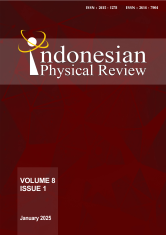ANALYSIS OF RAINFALL PATTERNS IN THE NUSA TENGGARA REGION USING THE FAST FOURIER TRANSFORM (FFT) METHOD AND ITS RELATIONSHIP WITH EL-NIÑO AND IOD
DOI:
10.29303/ipr.v8i1.397Downloads
Abstract
Changes in rainfall patterns have a significant impact on agriculture and water management in arid regions such as Nusa Tenggara. Water availability in this region is highly dependent on rainfall, which is influenced by global climate phenomena such as El-Niño and the Indian Ocean Dipole (IOD). This study aims to analyze the characteristics of rainfall patterns and analyze the relationship between rainfall and the El-Niño and IOD phenomena. Daily rainfall data from three BMKG observation stations in West Nusa Tenggara and East Nusa Tenggara during the period 1983-2022 were used in the analysis. The Fast Fourier Transform (FFT) method is used to identify periodic cycles, while the Pearson correlation test is used to determine the relationship of rainfall with El-Niño and IOD. The analysis shows that the Nusa Tenggara region is characterized by a monsoonal rainfall pattern with an annual cycle (12 months). Peak rainfall occurs in January and December, while the dry season lasts from July to September. The correlation of rainfall with El-Niño shows a weak negative relationship, while the influence of IOD is very small and varies between locations. The analysis shows that the rainfall pattern in the Nusa Tenggara region is monsoonal with an annual cycle (12 months) and semi-annual cycle (6 months). The peak of rainfall occurs from December to January, while the dry season lasts from July to September. The relationship between rainfall and El-Niño shows a weak negative correlation, so that when El-Niño increases, rainfall tends to decrease, and vice versa. The influence of IOD on rainfall is very small and varies between locations. Overall, while both El-Niño and IOD affect rainfall, their impact in the region is weak and more significant when both phenomena occur together.
Keywords:
FFT Rainfall Patterns El-Niño IOD Nusa TenggaraReferences
M. Hikmat, D. P. Hati, M. M. Pratamaningsih, and Sukarman, “Study on High Productivity Dryland in Nusa Tenggara for Agriculture Development (Kajian Lahan Kering Berproduktivitas Tinggi di Nusa Tenggara untuk Pengembangan Pertanian),†J. Sumberd. Lahan, vol. 16, no. 2, p. 119, 2023.
A. Mulyani and M. H. Suwanda, “Pengelolaan Lahan Kering Beriklim Kering untuk Pengembangan Jagung di Nusa Tenggara,†J. Sumberd. Lahan, vol. 13, no. 1, p. 41, 2020.
R. Matheus, M. Basri, M. S. Rompon, and N. Neonufa, “Strategi Pengelolaan Pertanian Lahan Kering Dalam Meningkatkan Ketahanan Pangan Di Nusa Tenggrara Timur,†Partner, vol. 22, no. 2, p. 529, 2017.
A. Suriadi, A. Mulyani, L. Hadiawati, and Suratman, “Biophysical characteristics of dry-climate upland and agriculture development challenges in West Nusa Tenggara and East Nusa Tenggara Provinces,†IOP Conf. Ser. Earth Environ. Sci., vol. 648, no. 1, 2021.
P. P. Simanjuntak and A. D. Nopiyanti, “Pengaruh Komponen Angin Zonal dan Meridional terhadap Curah Hujan Bulanan di Mempawah, Kalimantan Barat serta Pengaruh ENSO terhadap Variasinya,†J. Kumparan Fis., vol. 5, no. 3, pp. 187–192, 2023.
D. Setiawan, “Analisis Curah Hujan di Indonesia untuk Memetakan Daerah Potensi Banjir dan Tanah Longsor dengan Metode Cluster Fuzzy C-Means dan Singular Value Decompotition (SVD),†Eng. Math. Comput. Sci. J., vol. 3, no. 3, pp. 115–120, 2021.
M. I. Faishal, “Analisis Pola Curah Hujan Wilayah dan Indeks Kekeringan Berbasis Geographic Information System (GIS) di Provinsi Nusa Tenggara Timur (NTT),†Universitas Gadjah Mada, 2017.
S. B. Sipayung et al., “Proyeksi Neraca Air di Wilayah Nusa Tenggara Barat (NTB) Berdasarkan Luaran Model Conformal Cubic Atmospheric Model (CCAM),†J. Sains Dirgant., vol. 16, no. 2, pp. 79–90, 2019.
H. Akhsan, M. Irfan, Supari, and I. Iskandar, “Dynamics of Extreme Rainfall and Its Impact on Forest and Land Fires in the Eastern Coast of Sumatra,†Sci. Technol. Indones., vol. 8, no. 3, pp. 403–413, 2023.
M. N. Nur’utami and R. Hidayat, “Influences of IOD and ENSO to Indonesian Rainfall Variability: Role of Atmosphere-ocean Interaction in the Indo-pacific Sector,†Procedia Environ. Sci., vol. 33, pp. 196–203, 2016.
A. Scaife, E. Guilyardi, M. Cain, and A. Gilbert, “What is the El-Niño–Southern Oscillation?,†Weather, vol. 74, no. 7, 2019.
A. Kurniadi, E. Weller, S. K. Min, and M. G. Seong, “Independent ENSO and IOD impacts on rainfall extremes over Indonesia,†Int. J. Climatol., vol. 41, no. 6, pp. 3640–3656, 2021.
R. Bramawanto, F. Y. Prabawa, and I. R. Suhelmi, “The Effect of ENSO and IOD Climate Variability on Salt Production in Nusa Tenggara Islands,†J. Segara, vol. 18, no. 2, pp. 85–94, 2022.
M. Khairulbahri, “Analyzing the impacts of climate change on rice supply in West Nusa Tenggara, Indonesia,†Heliyon, vol. 7, no. 12, p. e08515, 2021.
M. I. Faishal, B. D. A. Nugoho, and P. Sudira, “Analisis Pola Curah Hujan Wilayah Dan Indeks Kekeringan Berbasis Geographic Information System (GIS) Di Provinsi Nusa Tenggara Timur (NTT),†2017, [Online]. Available: http://etd.repository.ugm.ac.id/penelitian/detail/115817
D. Susilokarti, S. S. Arif, S. Susanto, and L. Sutiarso, “Studi Komparasi Prediksi Curah Hujan Metode Fast Fourier Transformation (Fft), Autoregressive Integrated Moving Average (Arima) Dan Artificial Neural Network (Ann),†J. Agritech, vol. 35, no. 02, p. 241, 2015.
R. Albeta, I. Iskandar, H. Akhsan, and Suhadi, “Analisis Pola Curah Hujan di Wilayah Sumatera Bagian Utara Menggunakan Fast Fourier Transform (FFT),†J. Ilmu Fis. dan Pembelajarannya, vol. 8, no. 1, pp. 9–13, 2024.
D. Kurniawati, “Penaksiran Indeks Erosivitas Hujan dengan Metode Lenvain di Kecamatan Dau Kabupaten Malang,†Geodika J. Kaji. Ilmu dan Pendidik. Geogr., vol. 7, no. 1, pp. 33–42, 2023.
Rahmatika and J. Wiratmo, “The Effect of Rainfall Anomalies Due to Enso on tea Productivity in West Java Indonesia (Case Study: Bandung Regency),†IOP Conf. Ser. Earth Environ. Sci., vol. 1245, no. 1, 2023.
A. Bimaprawira and H. A. Rejeki, “Keterkaitan Periodisitas Curah Hujan di Daerah Pesisir dan Pegunungan Provinsi Jawa Timur dengan Variabilitas Cuaca Skala Global dan Regional,†J. Sains Teknol. Modif. Cuaca, vol. 22, no. 2, pp. 51–59, 2021.
N. Tulak, Y. Bungkang, and H. Huda, “Analisis Periodisitas dan Tren Curah Hujan di Kota Jayapura, Papua pada Periode 2001-2018,†J. Meteorol. dan Geofis. dan, vol. 23, no. 1, pp. 45–52, 2022.
A. K. Salma, E. Pratiwi Adi, W. Handayani, and S. Prayoedhie, “Analisis Koefisien Korelasi Peak Ground Acceleration dengan Metode Oliviera dan Shakemap BMKG, Studi Kasus Gempa Bumi Bantul 16 Januari 2022,†J. Stasiun Geofis. Sleman, vol. 1, no. 1, pp. 15–18, 2023.
L. M. Prayogo, “Pemetaan Suhu Permukaan Laut (SPL) dan Karakteristik Pasang Surut di Perairan Pulau Bali, Indonesia,†J. Laot Ilmu Kelaut., vol. 3, no. 1, pp. 1–12, 2021.
E. M. Lesik, H. L. Sianturi, A. S. Geru, and B. Bernandus, “Analisis Pola Hujan dan Distribusi Hujan Berdasarkan Ketinggian Tempat di Pulau Flores,†J. Fis. Fis. Sains dan Apl., vol. 5, no. 2, pp. 118–128, 2020.
M. W. Priyanto, A. P. Pratama, and I. Y. Prasada, “The Effect Of Fertilizer And Agricultural Machinery Subsidies On Paddy Productivity: A Feasible Generalized Least Squares Approach,†SEPA J. Sos. Ekon. Pertan. Dan Agribisnis, vol. 20, no. 1, pp. 56–68, 2023.
K. Muhammad Tahir, Y. Yin, Y. Wang, Z. A. Babar, and D. Yan, “Impact assessment of orography on the extreme precipitation event of July 2010 over Pakistan: a numerical study,†Adv. Meteorol., vol. 2015, no. 1, p. 510417, 2015.
S. Dwiratna, E. Suryadi, and K. D. Kamaratih, “Optimasi Pola Tanam Pada Lahan Sawah Tadah Hujan Di Kecamatan Cimanggung Kabupaten Sumedang,†J. Teknotan, vol. 10, no. 1, pp. 37–45, 2016.
U. Hidayat, S. Prasetyo, Y. Donni Haryanto, and N. Florida Riama, “Pengaruh ENSO Terhadap Curah Hujan dan Kelembapan Relatif serta Suhu Permukaan Laut di Sulawesi,†Bul. GAW Bariri, vol. 2, no. 2, pp. 88–96, 2022.
A. Nurlatifah and E. P. Wulandari, “Analysis of Rainfall Conditions Over Nusa Tenggara Barat During Enso Events Based on TRMM Data (Analisis Kondisi Curah Hujan Di Nusa Tenggara Barat Selama Terjadinya Enso Berdasarkan Data TRMM),†J. Sains Dirgant., vol. 17, no. 1, pp. 49–60, 2020.
S. Suhadi et al., “Morlet’s Wavelet Analysis on El-Niño Southern Oscillation (ENSO) and The Indian Ocean Dipole (IOD) for 84 Years: 1940-2023,†Indones. Phys. Rev., vol. 7, no. 3, pp. 552–561, 2024.
License

This work is licensed under a Creative Commons Attribution-NonCommercial-ShareAlike 4.0 International License.
Authors who publish with Indonesian Physical Review Journal, agree to the following terms:
- Authors retain copyright and grant the journal right of first publication with the work simultaneously licensed under a Creative Commons Attribution-ShareAlike 4.0 International Licence (CC BY SA-4.0). This license allows authors to use all articles, data sets, graphics, and appendices in data mining applications, search engines, web sites, blogs, and other platforms by providing an appropriate reference. The journal allows the author(s) to hold the copyright without restrictions and will retain publishing rights without restrictions.
- Authors are able to enter into separate, additional contractual arrangements for the non-exclusive distribution of the journal's published version of the work (e.g., post it to an institutional repository or publish it in a book), with an acknowledgment of its initial publication in Indonesian Physical Review Journal.
- Authors are permitted and encouraged to post their work online (e.g., in institutional repositories or on their website) prior to and during the submission process, as it can lead to productive exchanges, as well as earlier and greater citation of published work (See The Effect of Open Access).





